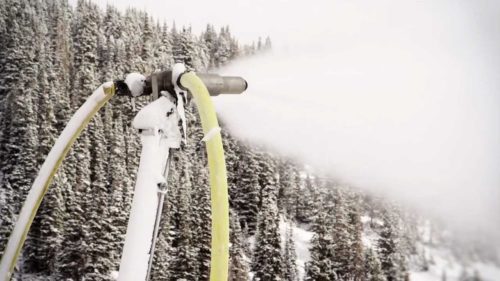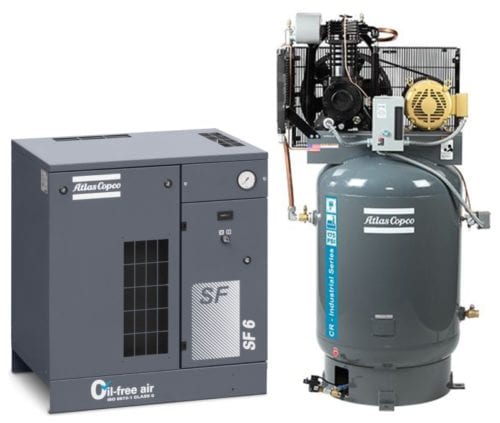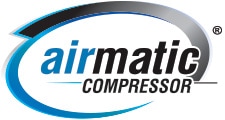Table of Contents
Click to View Section
News, Events and Happenings
New Hire
 We are pleased to announce a new member of the Airmatic Team, Samantha Gallucci. Sam joined Airmatic in September as an Aftermarket Service Specialist. Being the newest member of aftermarket team, her role is to help our service team to align closer with our customer’s needs and elevate the overall customer experience. Sam’s previous experience is within the maintenance, repair, and operations (MRO) industry so she understands the importance of critical infrastructure and uptime. She is looking forward to reaching out and working with all new and existing customer accounts. We are very excited for her to join our team!
We are pleased to announce a new member of the Airmatic Team, Samantha Gallucci. Sam joined Airmatic in September as an Aftermarket Service Specialist. Being the newest member of aftermarket team, her role is to help our service team to align closer with our customer’s needs and elevate the overall customer experience. Sam’s previous experience is within the maintenance, repair, and operations (MRO) industry so she understands the importance of critical infrastructure and uptime. She is looking forward to reaching out and working with all new and existing customer accounts. We are very excited for her to join our team!
Product Spotlight
Containerized Compressed Air Solutions – AIRCUBE
Many companies in our market area are thin on space to accommodate increased production demands. Installing production support equipment is oftentimes a challenge once the machinery that actually processes the end product is in place. Where do put the compressed air equipment which typically includes a compressor (or two), dryer, tank(s) and filter(s)?
Enter the Containerized Compressor Room or Aircube from Atlas Copco. Atlas Copco’s containerized compressor room delivers an instant solution to your most pressing and toughest compressed air needs. It’s a complete air system built into a standard shipping container, ready for operation upon delivery. Every AIRCUBE consists of proven, certified components, assembled to your specific requirements.
The AIRCUBE Containerized Compressor Room from Atlas Copco is the perfect plug-and-play solution for companies that are planning to build their own compressor rooms or for companies that don’t have space for a compressor room inside their factory premises.
The AIRCUBE allows companies that don’t have the time or space to add an indoor compressor room to quickly add or extend their compressed air capacity. It also solves a challenge many resource sector operations face: How do you get a dependable, high-quality air supply to some of the most remote places on this planet?
Customer Success Stories
An “Oil Free” Compressor System for $17,000…The Case for Reading Equipment Specifications
Bill Goerke, Systems Specialist
Many years ago, an Airmatic customer in the metal fabrication industry came to us requesting a compressor to run a new laser cutter for their production facility. Our customer advised, per the equipment OEM, the air was to be oil free air. As a cost savings measure, a pre-owned, CLASS ZERO…make note of that…was provided, and served the customer well until it was time for replacement.
We found it odd that a metal fab shop was using a…remember the term, CLASS ZERO oil free air compressor to run a laser cutter. So, when it came to replacing the old unit, we pressed the issue on what the OEM really meant by oil free. The customer provided Airmatic the OEM’s manual that listed the compressed air requirements; we learned that maximum allowable oil content in the air was to be 5mg/m3. Please look at the chart below, what is the ISO Class for Oil Concentration at 5mg/m3 ?

If you figured ISO Class 4…you are correct.
The customer purchased an Atlas Copco “G” Series, oil injected compressor outfitted with variable speed drive and integrated refrigerated dryer. For good measure the PD+ Series filter was added to achieve a CLASS ONE oil rating. Incidentally, a CLASS ZERO system of that size and durability would have been over TWICE the price.
CLASS ZERO is the only true OIL FREE.
In the end, Airmatic was able to provide energy efficient, clean, dry compressed air that was superior to the OEM specifications at a fraction of the projected equipment and maintenance costs.
Compressed Air Application Advice and Tools
Technical Project of the Month

My wife said, “I want to make a snow-man”
David Van’t Slot, System Specialist
Well, she actually said “Hey, do you want to go skiing this weekend”? Either way, I was going to take the opportunity to teach her a little something about how they make artificial snow. I began to tell her about the history and how they make snow as her eyes began to glaze over.
Artificial snow is a kind of a misnomer—it is actually real snow because the only ingredient is purified water, and that’s where the compressed air comes in. The trick is to take pure water and pump it through an oil-free compressed air stream. As the mixture blasts through nozzles the compressed air atomizes the water into super-small water droplets, as the water particles (30 microns) hit the freezing air and BAM – you have snow.
History of snow making?
Like almost any great invention, the discovery was made while doing research on something else. In the 1940s, Canadian researchers were studying how ice forms on airplane jet engines and during the study they decided to spray water through the jet engine in a refrigerated wind tunnel. The result was an indoor snow storm. Wow, they had invented man-made powder. Not long after, snowmaking machines began popping up at ski resorts in the northeast United States. Because of the unpredictability of natural snow fall, almost every ski resort relies on artificial snow to boost its base depth—or in some cases it makes up almost all of their snow. Advances in technology have allowed for snow making even in temperatures above freezing.
So, I said to my wife, “isn’t that cool?” She replied, “Just once—can’t you reply with ‘sure let’s go skiing’ and not a science lesson”?
Well, I guess that she was not impressed with my knowledge on the subject ;)
Benefits of Data Logging
Top 4 Reasons to Data Log Your Compressed Air System
Frank Asbaty, System Specialist
 Have you ever had to replace a compressor and the only information you have is the horsepower rating? Do you know your facility compressed air demand? Ever thought “man, this thing sure runs all the time, how much electricity is this costing me?” Ever wondered if your system is running efficiently, or just running? Do you know your % leak rate, and artificial demand? These are just some of the questions that can be answered through data logging your compressed air system.
Have you ever had to replace a compressor and the only information you have is the horsepower rating? Do you know your facility compressed air demand? Ever thought “man, this thing sure runs all the time, how much electricity is this costing me?” Ever wondered if your system is running efficiently, or just running? Do you know your % leak rate, and artificial demand? These are just some of the questions that can be answered through data logging your compressed air system.
Consider these statistics from the Compressed Air and Gas Institute (CAGI): It’s estimated that in the United States alone, $3.2 billion dollars in energy costs are wasted annually by compressed air systems. This number only accounts for the amount of energy lost through inefficiency, not the energy converted into usable compressed air power. #mindboggling
Too often, businesses fail to audit and log their compressed air performance efficiency. In other words, they are wasting power and they don’t even know it.
Here are the top 4 reasons to apply data and pressure loggers to your compressed air system.
- Establish a baseline- One of the most important steps of managing a compressed air system is to develop a baseline. This acts as a point of reference. By logging kilowatt hours (kWh), which is a standard unit for understanding energy consumption, you will develop a baseline of energy consumption, and compressed air consumption. Understanding the kWh usage of your system is important as this is how you are charged for electricity. The flow usage baseline is also very helpful in upsizing or downsizing your next compressor to meet your current demand, which may fluxuate with your business levels.
- Ensure pressure stability- Utilizing pressure loggers to track changes in air pressure in your system is an effective way to identify large demand events causing production issues, calculate artificial demand and leak loads, and develop a plan to stabilize pressure with the use of a demand expander valve.
- Equipment Sizing- Before starting replacement projects or updating equipment, consider installing data loggers to help size air compressors. If you purchase the same size equipment as currently installed, you may be operating off of assumptions of correct sizing, and creating new problems. Data loggers provide a snapshot of your system operation to avoid inaccurate assumptions, and (expensive) incorrect sizing decisions.
- Savings, Savings, Savings- by data logging your system, getting a baseline, uncovering true demand vs true supply and the energy costs associated, you will have the tools to make educated decisions to increase your system’s efficiency. Without data logging, you’re simply guessing. With potentially thousands to hundreds of thousands of energy dollars annually on the line, do you really want to guess about your compressed air systems efficiency?
Don’t take chances and guess about your compressed air systems’ efficiency. Contact Airmatic Compressor and inquire about our state-of-the-art data logging equipment and analysis for your business or facility.
Service Event of the Month
Using Shock Pulse Method monitoring to predict your maintenance future and avoid costly failures – Part I
William De Luca, Director of Technical Services

In almost all manufacturing processes, there are numerous pieces of rotating equipment that keep production going. In many cases, air compressors are major contributors to production outputs, so when they are down expectantly, it can have a significant impact on a business.
One of the tools utilized in rotating equipment and compressor maintenance is Shock Pulse Method (SPM) monitoring. The SPM method is a monitoring system which is used to analyze the performance of bearings in major rotating components like an air compressor’s air-end(s) and motor.
The SPM monitoring process involves taking periodic readings and tracking the bearing sound levels in decibels dB over time. If there is a dramatic increase in the sound levels observed in a short interval of time, that usually is an indicator that a bearing failure may be upcoming in the near future. Also, a steady upward trend over time would be something to monitor very closely.
Having your compressor go down for any reason can for sure have various impacts on the production process and lead to significant losses. Therefore, getting this sort of predictive information can be very helpful in taking proactive actions on component maintenance or replacement before an unexpected failure would occur.
Failures related to major compressor components such as air-ends and motors, can obviously be very expensive, as well as having some potential for extended parts lead-times, and that will delay a business in getting back up and running again. Also, in cases where this is no redundant backup compressor(s) available, rental compressors would have to be obtained quickly at an additional cost etc.
After Market at its Best
Do you have a contingency plan? (Part 1 of 2)
Craig Verga, Director of Aftermarket
 You know that old saying, “stuff happens?” If 2020 has taught us anything, it’s that there are many factors that are out of our control. For those whose job it is to assure business continuity for their organization, this year has been an eye opener. So that begs the question, do you have a contingency plan for your compressed air, nitrogen, and vacuum systems? After all, this is critical infrastructure to operate your business.
You know that old saying, “stuff happens?” If 2020 has taught us anything, it’s that there are many factors that are out of our control. For those whose job it is to assure business continuity for their organization, this year has been an eye opener. So that begs the question, do you have a contingency plan for your compressed air, nitrogen, and vacuum systems? After all, this is critical infrastructure to operate your business.
The first piece to that is determining if you have redundancy. Redundancy in an industrial plant is usually defined as N+1. N refers to the number of machines needed to meet the design load, so N+1 indicates one spare for maintenance or failures.
A simple example of this is your car. You have four tires, but only one spare. That’s N+1. Of course, if you end up with a flat tire you have everything you need to change it and get back on your way quickly. Cars come with the spare tire, a tire iron to remove the lug nuts, and a jack. But that’s not typically the case with your plant’s compressed air, nitrogen, and vacuum systems.
We typically find that about half of our customers have N+1 redundancy. For those that do, a mechanical failure or planned maintenance event is a simple inconvenience that is easily dealt with. Simply open a valve, or turn on a machine and they are back in operation. However, for those customers who cannot manage an event like this so simply, there are a couple of options to explore.
Do you have redundancy for your critical infrastructure? The cost of downtime for your business can far outweigh the cost of installing the mechanical infrastructure and asset redundancy needed to keep things running In part two next month we’ll explore different ways to accomplish this.
Vacuum Systems
Vacuum Inlet Filtration – Block the Pump from the Junk
Jeremy Garfield, Director of Sales
Imagine your job was to be the central vacuum pump for an industrial facility. You show up at 9AM, and all day long you had to suck on a straw to provide vacuum to the plant. Regardless of how delicious or disgusting the end product is, wouldn’t you want some type of filter on the straw?
While this simplified example makes it seem obvious that utilizing proper inlet filtration is imperative, many plants still ignore inlet filtration, or assume the standard supplied filter will work fine with for application.
The type and level of filtration applied to your industrial vacuum system should be designed with all potential contaminants in mind, and engineered to protect the vacuum pump, as well as optimize the system performance through minimized pressure drop. These filters should be added to the regular maintenance schedule and changed religiously.
Lack of filtration can cause many problems with a vacuum pump. For dry pumps, lack of filtrations can create dirt deposits on dry claws which reduce tolerances and cause seize-ups. For oil-sealed units, infiltration of harmful contaminants can mix with the oil, creating a chemical that attacks seals and causes damage to the pump.
Below are a set of clean claws from a dry-claw vacuum pump, and a set of claws whose system had no filtration. Imagine sucking that junk through a straw all day?



Market Performance Information
Watching and Waiting
Michael Johnson
 Winter is fast approaching and so is the end of 2020. What a roller coaster ride of a year it has been! The first quarter for Airmatic was nothing less than record setting. We were off to the races growing business, market share and employee morale. In March, the pandemic black swan was released and so were the lockdowns on businesses. We all collectively held our breath for several weeks, then slowly opened the figurative hatch and with full PPE and engaged the marketplace. Business slowly started up again, activity swelled at first then leveled off as companies came to grips with the “new reality”.
Winter is fast approaching and so is the end of 2020. What a roller coaster ride of a year it has been! The first quarter for Airmatic was nothing less than record setting. We were off to the races growing business, market share and employee morale. In March, the pandemic black swan was released and so were the lockdowns on businesses. We all collectively held our breath for several weeks, then slowly opened the figurative hatch and with full PPE and engaged the marketplace. Business slowly started up again, activity swelled at first then leveled off as companies came to grips with the “new reality”.
The wind was surely out of the economic sails as capital equipment budgets were off the table and owners and managers struggled to determine future business demand. Currently, a significant number of jobs scheduled for 2020 have been pushed into 2021 in an attempt to deal with the renewed downward pressure as the anticipated pandemic 2nd wave takes hold.
All eyes are on 2021 as we await the flu to run its course and the presidential election to provide closure. One thing we can count on is that once confidence is back, the rebound effect or pent-up demand should power significant growth opportunities for most businesses and industries.
January Sales Specials

To welcome in the New Year, Airmatic Compressor is offering 10% off on all Atlas Copco SF Series scroll compressors and CR Series reciprocating compressors. Don’t miss out on these savings, this sale ends 1/31/2020.
